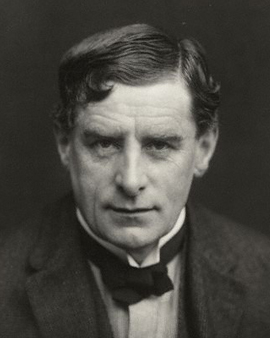Already during his lifetime the artistic talent of the English painter Walter Richard Sickerts was recognized. In the years after his death, his reputation as one of the most influential artists in England in the 20th century grew even further. He is regarded worldwide as a dazzling, fascinating personality. Independently of common currents, he devoted himself to modernity and progress.
As a talented storyteller, he was well received in cultural and social circles and cultivated connections with numerous well-known people of his time. As his fame grew, he adopted an increasingly eccentric style in his appearance and behaviour, which, like his many works, attracted attention in society. As the eldest of six children, he initially lived in Munich until his family emigrated to England in 1868. After some theatre roles he finally turned to his passion, painting. He attended courses at the Slade School of Fine Art until he joined the American artist James Abbott McNeill Whistler as a studio assistant. Later he met Edgar Degas. Both had a lasting influence on his painting style. As a cosmopolitan he travelled a lot and exchanged experiences with other painters.
While in his early artistic years he devoted himself to landscape painting, his later works reflected the colourful hustle and bustle in London's music halls. In addition, he set priorities in his work with portraits and domestic everyday scenes. In addition, he himself taught young artists. At an advanced age Sickert often used photographs as the basis for his works, which Degas advised him to do. In 1941, one year before his death, he was honored with a solo exhibition at the National Gallery.
×





.jpg)
.jpg)
.jpg)
.jpg)
_-_(MeisterDrucke-892733).jpg)
_-_(MeisterDrucke-892733).jpg)
.jpg)
.jpg)
.jpg)
.jpg)
.jpg)
.jpg)
.jpg)
.jpg)
.jpg)
.jpg)
.jpg)
.jpg)
.jpg)
.jpg)
_-_(MeisterDrucke-1533806).jpg)
_-_(MeisterDrucke-1533806).jpg)
.jpg)
.jpg)
_-_(MeisterDrucke-1641516).jpg)
_-_(MeisterDrucke-1641516).jpg)
.jpg)
.jpg)
.jpg)
.jpg)
 - (MeisterDrucke-267629).jpg)
 - (MeisterDrucke-267629).jpg)
.jpg)
.jpg)
.jpg)
.jpg)
 Dieppe - (MeisterDrucke-205628).jpg)
 Dieppe - (MeisterDrucke-205628).jpg)
.jpg)
.jpg)
_-_(MeisterDrucke-1426114).jpg)
_-_(MeisterDrucke-1426114).jpg)
 1907 - (MeisterDrucke-176807).jpg)
 1907 - (MeisterDrucke-176807).jpg)
.jpg)
.jpg)
.jpg)
.jpg)
_1928_-_(MeisterDrucke-170504).jpg)
_1928_-_(MeisterDrucke-170504).jpg)
.jpg)
.jpg)
.jpg)
.jpg)
.jpg)
.jpg)
_-_(MeisterDrucke-1130544).jpg)
_-_(MeisterDrucke-1130544).jpg)
.jpg)
.jpg)
.jpg)
.jpg)
.jpg)
.jpg)
.jpg)
.jpg)
.jpg)
.jpg)
.jpg)
.jpg)
 - (MeisterDrucke-252977).jpg)
 - (MeisterDrucke-252977).jpg)
![The River [After John Gilbert], c. 1930-31 by Walter Richard Sickert The River [After John Gilbert], c. 1930-31 by Walter Richard Sickert](/kunstwerke/300px/Walter_Richard_Sickert_-_The_River_After_John_Gilbert_c_1930-31_(Oil_on_canvas)_-_(MeisterDrucke-1534116).jpg)
![The River [After John Gilbert], c. 1930-31 by Walter Richard Sickert](/kunstwerke/400w/Walter_Richard_Sickert_-_The_River_After_John_Gilbert_c_1930-31_(Oil_on_canvas)_-_(MeisterDrucke-1534116).jpg)
_-_(MeisterDrucke-1172468).jpg)
_-_(MeisterDrucke-1172468).jpg)
.jpg)
.jpg)
.jpg)
.jpg)
 - (MeisterDrucke-160090).jpg)
 - (MeisterDrucke-160090).jpg)
_-_(MeisterDrucke-902686).jpg)
_-_(MeisterDrucke-902686).jpg)
.jpg)
.jpg)
_-_(MeisterDrucke-1628244).jpg)
_-_(MeisterDrucke-1628244).jpg)
.jpg)
.jpg)
_-_(MeisterDrucke-900360).jpg)
_-_(MeisterDrucke-900360).jpg)
.jpg)
.jpg)
_-_(MeisterDrucke-1465737).jpg)
_-_(MeisterDrucke-1465737).jpg)
.jpg)
.jpg)
.jpg)
.jpg)
.jpg)
.jpg)
.jpg)
.jpg)
_-_(MeisterDrucke-1465763).jpg)
_-_(MeisterDrucke-1465763).jpg)
.jpg)
.jpg)
_-_(MeisterDrucke-319755).jpg)
_-_(MeisterDrucke-319755).jpg)
.jpg)
.jpg)
.jpg)
.jpg)
.jpg)
.jpg)
.jpg)
.jpg)
.jpg)
.jpg)
.jpg)
.jpg)
.jpg)
.jpg)
.jpg)
.jpg)
.jpg)
.jpg)
.jpg)
.jpg)
_-_(MeisterDrucke-1106262).jpg)
_-_(MeisterDrucke-1106262).jpg)
.jpg)
.jpg)
.jpg)
.jpg)
.jpg)
.jpg)
_-_(MeisterDrucke-926775).jpg)
_-_(MeisterDrucke-926775).jpg)
.jpg)
.jpg)
.jpg)
.jpg)
.jpg)
.jpg)
_-_(MeisterDrucke-1113180).jpg)
_-_(MeisterDrucke-1113180).jpg)
_c1896_(oil_on_canvas)_-_(MeisterDrucke-1129781).jpg)
_c1896_(oil_on_canvas)_-_(MeisterDrucke-1129781).jpg)
_The_Gallery_of_the_Old_Bedford_(verso)_-_(MeisterDrucke-1283312).jpg)
_The_Gallery_of_the_Old_Bedford_(verso)_-_(MeisterDrucke-1283312).jpg)
.jpg)
.jpg)
.jpg)
.jpg)
.jpg)
.jpg)
.jpg)
.jpg)
_-_(MeisterDrucke-1520086).jpg)
_-_(MeisterDrucke-1520086).jpg)
.jpg)
.jpg)
.jpg)
.jpg)
_-_(MeisterDrucke-1131637).jpg)
_-_(MeisterDrucke-1131637).jpg)
.jpg)
.jpg)
_-_(MeisterDrucke-1133830).jpg)
_-_(MeisterDrucke-1133830).jpg)
.jpg)
.jpg)
.jpg)
.jpg)
.jpg)
.jpg)
.jpg)
.jpg)
.jpg)
.jpg)
.jpg)
.jpg)
.jpg)
.jpg)
_-_(MeisterDrucke-1127327).jpg)
_-_(MeisterDrucke-1127327).jpg)
.jpg)
.jpg)
_-_(MeisterDrucke-1129543).jpg)
_-_(MeisterDrucke-1129543).jpg)
_-_(MeisterDrucke-1117708).jpg)
_-_(MeisterDrucke-1117708).jpg)
.jpg)
.jpg)
.jpg)
.jpg)
.jpg)
.jpg)






